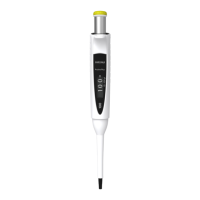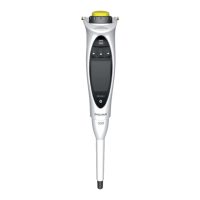11
or in %: e
S
= 100 (V- V
S
)/V
S
13. For conformity evaluation, calculate the random error of the measurement:
as standard deviation
n = number of measurement (10)
or as coefficient of variation CV = 100s/V
14. Compare the systematic error (inaccuracy) and random error
(imprecision) with the values in the performance specifications - (p.
97) or the specifications of your own laboratory. If the results fall within
the specifications, the pipette is ready for use. Otherwise check both
systematic and random errors and, when necessary, proceed to the
recalibration procedure (Chapter 11.2).
Note: Systemic error (inaccuracy) is the difference between the dispensed
volume and the selected test volume. Random error (imprecision) is the
scatter of the dispensed volumes around the mean of the dispensed
volume. (ISO 8655-1.)
Note:
Sartorius specifications are achieved in strictly controlled conditions
(ISO 8655-6). The user should establish own specifications based on the field
of use and the accuracy requirements placed on the pipette (ISO 8655-1).
Z-values (µl/mg)
Temp. (°C) Air Pressure (kPa)
95 100 101.3 105
20.0
20.5
21.0
21.5
22.0
22.5
23.0
23.5
1.0028
1.0029
1.0030
1.0031
1.0032
1.0033
1.0034
1.0036
1.0028
1.0029
1.0031
1.0032
1.0033
1.0034
1.0035
1.0036
1.0029
1.0030
1.0031
1.0032
1.0033
1.0034
1.0035
1.0036
1.0029
1.0030
1.0031
1.0032
1.0033
1.0034
1.0036
1.0037
Note: This method is based on ISO 8655.
11.2. Recalibration
The calibration of your Proline
®
Plus pipette has been factory-checked
by using forward pipetting technique and certified at 22°C using grade
3 distilled water according to ISO 3696. The calibration is based on ISO
8655-6: Gravimetric test method for volumetric instruments. The pipette's
specifications are guaranteed only with genuine Sartorius tips. If you find
the pipette to be inaccurate after performance testing, please follow the
instructions below:
1. Remove the lid of the calibration nut, located on the back of the handle,
with the aid of the calibration tool.
2. Place the hexagonal head of the calibration tool into the hole of the
calibration nut.
3. Turn the adjustment lock counterclockwise to decrease and clockwise to
increase the volume.
4. Repeat testing the performance procedure (Chapter 11.1.). Continue
until the results are correct.
Note: Recalibration is recommended if reverse pipetting technique is used.
Note: Sartorius offers accredited calibration service. Please contact your
local Sartorius representative for further information.

